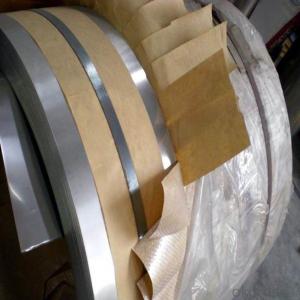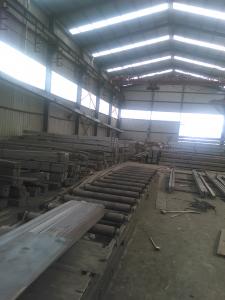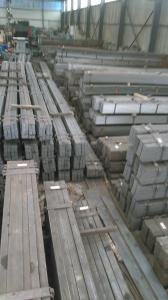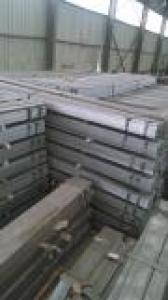High carbon spring steel hot rolled flat bar
- Loading Port:
- Tianjin
- Payment Terms:
- TT OR LC
- Min Order Qty:
- 1200 PCS
- Supply Capability:
- 24000 PCS/month
OKorder Service Pledge
Quality Product, Order Online Tracking, Timely Delivery
OKorder Financial Service
Credit Rating, Credit Services, Credit Purchasing
You Might Also Like
High Carbon Spring Steel Hot Rolled Flat Bar Specifications:
Spring flat steel for leaf spring:
1.Certificates:ISO9001/SGS/BV.
2. Supply ability:2000Tons/day
3. 22 years experience
Production Name | Spring Steel Flat Bar |
Steel Type | Spring Steel |
Material | 60Si2Mn |
Others Available Material | 60Si2Mn, SUP9, SUP9A, 55Cr3 etc. |
Thickness Range (mm) | 6-50 |
Width Range (mm) | 40-135 |
Usual length (mm) | 5800 |
Daily Capacity (Metric Ton) | 4000 |
Certificate | ISO9001: 2008 |
Edge | Round Edge / Right Angle |
Surface | None |
Usage | Leaf Springs, Cultivator Blades, Garden Tools, Knifes etc. |
Samples | Free of Charge |
- Q:Can steel flat bars be used for creating partitions or room dividers?
- Yes, steel flat bars can indeed be used for creating partitions or room dividers. Their strong and rigid nature makes them suitable for providing structural support and stability. Additionally, steel flat bars can be welded, bolted, or attached in various ways to create a sturdy and durable room divider.
- Q:Can steel flat bars be cold-formed or bent?
- Yes, steel flat bars can be cold-formed or bent. Cold-forming or bending is a process that involves shaping the metal at room temperature without the use of heat. Steel flat bars are commonly cold-formed or bent to create various shapes, angles, or curves to suit specific applications and designs. The process typically involves using specialized machinery such as press brakes or rollers to exert force on the steel flat bar, causing it to deform and take on the desired shape. Cold-forming or bending steel flat bars allows for precise customization and flexibility in design, making them suitable for a wide range of industries and applications such as construction, manufacturing, and engineering.
- Q:How is three grade steel connected to ground flat steel?
- HRB400 can be directly welded by hand arc welding with Q235 flat steel into electrical circuit. (I have done two sets of tensile tests last year, qualified).
- Q:Can steel flat bars be used for making telecommunications industry equipment?
- Telecommunications industry equipment can indeed be made using steel flat bars. Steel is a widely utilized material in the manufacturing of various equipment owing to its robustness, longevity, and cost-effectiveness. The construction of equipment racks, supports, brackets, and frames for housing telecommunications equipment like servers, switches, routers, and antennas can all make use of steel flat bars. These bars' flat shape permits simple fabrication and customization to meet specific design requirements. Furthermore, steel's corrosion resistance is vital for telecommunications equipment that may encounter harsh environmental conditions. All in all, steel flat bars serve as a fitting option for the construction of telecommunications industry equipment.
- Q:What are the different methods of surface buffing for steel flat bars?
- There are several methods of surface buffing for steel flat bars, each with its own advantages and applications. Some of the most common methods include: 1. Hand buffing: This method involves using a handheld buffing wheel or pad to manually polish the surface of the steel flat bar. It is a cost-effective option for small-scale projects and provides a good level of control over the buffing process. 2. Machine buffing: Machine buffing utilizes powered buffing machines equipped with rotating wheels or pads to buff the steel flat bars. This method offers faster and more consistent results compared to hand buffing, making it suitable for large-scale projects or industrial applications. 3. Abrasive belt buffing: This method involves using abrasive belts, usually made of sandpaper or cloth, to remove imperfections and achieve a smooth surface on the steel flat bar. It is a versatile technique that can be used for both light and heavy buffing, depending on the grit size of the belt. 4. Chemical buffing: Chemical buffing involves the use of specialized chemicals or compounds to remove oxidation, stains, or other surface contaminants from the steel flat bar. This method is often used in conjunction with mechanical buffing to achieve a high-quality finish. 5. Electropolishing: Electropolishing is an electrochemical process that removes a thin layer of material from the steel flat bar's surface, resulting in a smooth, mirror-like finish. It is commonly used in industries where hygiene and corrosion resistance are critical, such as pharmaceutical or food processing. Each of these methods has its own advantages and limitations, and the choice of the most suitable method depends on factors such as the desired finish, project scale, available equipment, and budget. It is essential to consider these factors and consult with professionals or experts in the field to determine the best method for surface buffing steel flat bars.
- Q:How do steel flat bars compare to other forms of steel like angles or channels?
- Steel flat bars, angles, and channels are all versatile and commonly used forms of steel. However, they differ in terms of their structural characteristics and applications. Steel flat bars are typically rectangular in shape with a flat surface, making them ideal for structural support, framing, and industrial applications where a flat surface is required. On the other hand, steel angles have an L-shaped cross-section, providing superior strength and stability, making them suitable for construction projects, bracing, and framework. Steel channels, with a U-shaped cross-section, offer excellent load-bearing capabilities, making them popular for applications such as beams, supports, and vehicle frames. Ultimately, the choice between these forms of steel depends on the specific requirements of the project at hand.
- Q:What are the different types of surface defects in galvanized steel flat bars?
- The different types of surface defects in galvanized steel flat bars can include dents, scratches, corrosion, uneven coating, and zinc skimmings.
- Q:What is the maximum temperature steel flat bars can withstand?
- The maximum temperature that steel flat bars can withstand depends on the specific grade of steel being used. However, in general, most steel flat bars can withstand temperatures up to around 1,000 degrees Celsius (1,832 degrees Fahrenheit) without experiencing significant structural changes or loss of strength. It is important to consult the manufacturer or specific technical data sheets for accurate temperature limits based on the grade of steel being used.
- Q:What is the yield strength of a steel flat bar?
- The yield strength of a steel flat bar can vary depending on the specific grade and composition of the steel. It typically ranges from 36,000 to 80,000 pounds per square inch (psi).
- Q:Can steel flat bars be used for making shelving units?
- Yes, steel flat bars can definitely be used for making shelving units. Steel flat bars are strong and durable, making them an excellent choice for shelving units that need to support heavy items. They can be easily cut and welded to create the desired size and shape of the shelving unit. Steel flat bars also have a sleek and modern look, making them suitable for various styles of interiors. Additionally, steel is resistant to corrosion, which ensures that the shelving units will last for a long time without rusting or deteriorating. Overall, steel flat bars are a reliable and versatile material for constructing sturdy and functional shelving units.
1. Manufacturer Overview |
|
|---|---|
| Location | |
| Year Established | |
| Annual Output Value | |
| Main Markets | |
| Company Certifications | |
2. Manufacturer Certificates |
|
|---|---|
| a) Certification Name | |
| Range | |
| Reference | |
| Validity Period | |
3. Manufacturer Capability |
|
|---|---|
| a)Trade Capacity | |
| Nearest Port | |
| Export Percentage | |
| No.of Employees in Trade Department | |
| Language Spoken: | |
| b)Factory Information | |
| Factory Size: | |
| No. of Production Lines | |
| Contract Manufacturing | |
| Product Price Range | |
Send your message to us
High carbon spring steel hot rolled flat bar
- Loading Port:
- Tianjin
- Payment Terms:
- TT OR LC
- Min Order Qty:
- 1200 PCS
- Supply Capability:
- 24000 PCS/month
OKorder Service Pledge
Quality Product, Order Online Tracking, Timely Delivery
OKorder Financial Service
Credit Rating, Credit Services, Credit Purchasing
Similar products
New products
Hot products
Related keywords

























